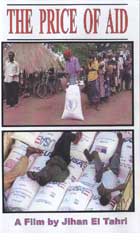
The Price of Aid 2004
Distributed by First Run/Icarus Films, 32 Court St., 21st Floor, Brooklyn, NY 11201; 800-876-1710
Produced by Dominant 7
Directed by Jihan el Tahri
VHS, color, 55 min.
Sr. High - Adult
African Studies, Agriculture, Economics, International Relations, Postcolonialism
Date Entered: 02/11/2005
Reviewed by Patricia B. McGee, Coordinator of Media Services, Volpe Library & Media Center, Tennessee Technological UniversityJihan el Tahri’s The Price of Aid is a profoundly disturbing examination of the politics of international food relief distribution and its effect on developing African nations. While food aid is seen as a “good and charitable deed,” it is also part of a system that feeds on crises, and while trying to solve problems, at the same time “creates others - less visible and more destructive.” While it is good for American agribusiness, it does not always benefit Africans and African agriculture.
In 2002 Zambia and five neighboring nations experienced a food crisis. For Zambia, the difficulty was limited to one of its nine provinces. The nation asked for limited food aid, as according to the Zambian government, the food crisis “was localized and temporary.” What happened was that international food aid agencies alerted the world media that there was an enormous crisis in the region. The World Food Program, which has the United States as its biggest donor, mobilized and tons of maize [corn] started to make its way to southern Africa. According to Guy Scott, former Zambian minister of agriculture, the crises was exaggerated because it suited everyone. Aid agencies receive donations; farmers find a market for surplus crops.
President Levy Mwanawasa of Zambia then announced in the United Nations that the nation categorically refused to accept genetically modified grain. The result was not mass starvation, but that Zambian unpopularity with aid organizations went into “free fall.” Mundia Sikatana, the current Zambian minister of agriculture, points out possible long term health risks in that Zambians consume maize in far greater quantities than do Americans; Zambian seed banks of environmentally adapted plants could be lost; GM seeds are patented so farmers would have to pay for seed instead of following traditional practices of saving seed from the present harvest for future crops; GM foods grown in Africa would face import restrictions from the EU. Sikatana asked why not include sorghum, oil and non-GM crops in food aid programs. His bitter response was that “beggars have to accept what they get.”
The issue of famine and food relief in Africa is a complex one. In part crop failures are due to the vagaries of the weather, yet economic policies of the International Monetary Fund and the World Bank have had a negative impact on small farmers as has had governmental corruption and HIV-AIDS. While European Union states purchase local grain and try to respect local sensibilities, U.S. farm aid, on the other hand, is circumscribed by Public Law 480. All donated food must be U.S. made products, including the cans, the boxes, the ink on the labels, even though in a crisis might be faster to send cash and permit purchasing in nearby markets. American food aid has at its heart the purpose of protecting the heavily subsidized American farmer.
The Price of Aid is a lucid examination of a very tangled, complex issue. El Tahri does a fine job of presenting the many voices and points of view within a clearly understandable framework. The video, sound, and color are excellent. This very thought provoking documentary provides a good starting point for a discussion of difficult and multifaceted issues. The Price of Aid is an essential addition to collections of African and postcolonial studies.